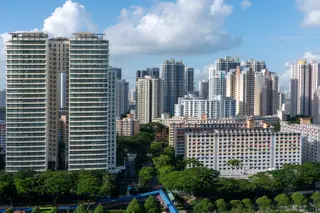Navi Mumbai Real Estate: Luxury vs Affordable Strategies
 Navi Mumbai’s residential market offers distinct opportunities for buyers across different price ranges, shaped by diverging trends in luxury and affordable segments. While luxury properties face oversupply challenges, affordable housing struggles with limited inventory, creating unique strategic landscapes for investors and end-users.
Navi Mumbai’s residential market offers distinct opportunities for buyers across different price ranges, shaped by diverging trends in luxury and affordable segments. While luxury properties face oversupply challenges, affordable housing struggles with limited inventory, creating unique strategic landscapes for investors and end-users.
Luxury Housing Trends and Buyer Priorities
Recent data shows a 36% year-on-year surge in unsold luxury apartments priced above ₹2.5 crore in Mumbai, reflecting oversupply despite strong demand. Navi Mumbai’s premium segment mirrors this dynamic, with 16,480 luxury units added in 2024 and 5,294 more in Q1 2025. Buyers here should focus on:
- Strategic location: Proximity to proposed infrastructure like Navi Mumbai International Airport or CBDs
- Developer credibility: Projects by established names with reputations for quality and timely delivery
- Future-proof amenities: Smart home technology, concierge services, and exclusive wellness centers
- Price-per-square-foot analysis: Prioritize projects with competitive rates in prime areas
Affordable Housing Dynamics
Affordable housing faces shrinking supply, driven by delayed project launches and high land costs. Strategies here revolve around:
- Built-up area optimization: Prioritize functional spaces over decorative elements
- Infrastructure connectivity: Prefer new construction near upcoming metro lines
- Government incentives: Leverage subsidies like PMAY (though less prominent in recent Navi Mumbai data)
- Essential amenities: Community gyms, children’s parks, yoga desk, and basic security systems
Value Retention Strategies
| Segment | Retain Value Via | Key Challenges |
|---|---|---|
| Luxury | Capital appreciation, rental yields | Market volatility, oversupply |
| Affordable | Steady demand, infrastructure growth | Limited upside, supply scarcity |
Luxury buyers must navigate cyclical demand, while affordable investors benefit from stable occupancy rates. Hybrid projects blending affordability with selective luxury amenities could offer balanced returns.
Lifestyle Amenities: A Comparative View
Luxury Offerings
- Private swimming pools, rooftop helipads, and designer interiors
- Concierge services, smart home integration, and exclusive social clubs
Affordable Amenities
- Community spaces for cultural activities
- Proximity to schools, institutes, markets, and healthcare facilities
- Basic recreational areas like playgrounds
Market Trend Outlook
Recent registrations in Mumbai hit record highs (64,461 properties in 2025), signaling robust demand despite oversupply in luxury niches. Navi Mumbai’s peripheral areas are emerging as hotspots for affordable projects, while luxury developments cluster around established commercial corridors. Knight Frank data highlights a 483% surge in ultra-luxury sales, indicating niche demand despite broader oversupply.
Final Strategic Recommendations
- Luxury buyers: Target distressed sales or under-renovation projects for negotiated rates
- Affordable investors: Monitor pre-launch offerings with future infrastructure alignments
- First-time buyers: Prioritize affordability with a focus on transit-oriented development (TOD) locales
Navi Mumbai’s market rewards buyers who align purchasing power with long-term goals. Luxury seekers must balance aspiration with financial prudence, while affordable buyers capitalize on persistent demand to secure stable assets. Tracking developer activity and government infrastructure plans remains critical for both segments.